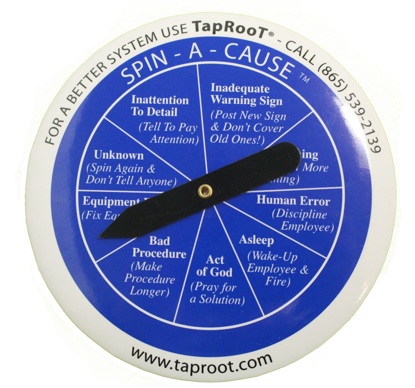Six Steps to Human Performance Improvement

The Six Steps to Human Performance Improvement…
Here are the six steps to human performance improvement:
- Understand why people make errors.
- Understand how to make errors less likely.
- Understand why errors are happening at your company.
- Remove Hazards and Target if possible.
- Choose human performance improvement tools that target the most likely and most important reasons for human errors.
- Trend performance and continuously improve using reactive and proactive practices.
Of course, all the above steps to human performance improvement require management support. Therefore, you will need to develop management’s understanding of human error and of the value that stopping human error. To calculate the cost of human error, see THIS LINK.
Let’s look at each of the steps in more detail.
1st Step to Human Performance Improvement
Before improving human performance, you must understand why people make errors. I discovered the causes of human error after spending five years in the Nuclear Navy. I had seen human errors, but I didn’t really understand why they happened or what we could do to stop them. Our “root cause analysis” seemed to lead to the standard three corrective actions:
- TRAINING (usually more training or retraining)
- DISCIPLINE (starting with telling the operator to be more careful and escalating to Captain’s Mast or even De-Nuking)
- PROCEDURES (usually writing a procedure or making the current procedure longer)
Do those three corrective actions seem like your standard three corrective actions?
My last job in the Navy was as an Assistant Professor at the University of Illinois. Luckily, at the same time, I was able to study for a Master’s Degree in Nuclear Engineering with an emphasis on Human Factors. The program was new, and my advisor (Dr. Charles O. Hopkins) and I designed the program from scratch.

Dr. Hopkins was a Fellow in the Human Factors Society and a past-president of the organization. He was a human factors guru and taught my first Human Factors course. The course was a real eye-opener. Every day, I learned a new reason why people in the Nuclear Navy had made mistakes. Plus, I could see ways to prevent those mistakes.
Over the next two years of intense research and study, and with my Nuclear Navy practical experience in high-reliability operations, I became a human factors expert who could understand why people make human errors.
How will you take the first step to understanding why people make errors? Keep reading, and we will lay out a roadmap for you.
2nd Step to Human Performance Improvement
As I mentioned above, in the course of my studies, I not only could see the reasons for human errors, but I could also see ways to prevent human errors. These were practical improvement ideas that could be implemented in the field. That’s the second step to human performance improvement – understanding how to make human errors less likely.
However, after starting System Improvements, developing TapRooT® Root Cause Analysis, and teaching hundreds of people how to find root causes, I realized that others often couldn’t see practical ways to improve human performance. They kept trying to use the three standard corrective actions (training, discipline, and procedures) that I had previously thought were the standard ways to improve human performance.
Now, it’s not that training, discipline, and procedures aren’t sometimes needed. They may be required. It is just that there are many more (and more effective) ways to improve human performance.
Therefore, I wrote the Corrective Action Helper® Guide as a tool to include in the TapRooT® Root Cause Analysis System to help people develop more effective corrective actions.
However, there are more human performance improvement tools than those in the guide. Therefore, to develop an effective human performance improvement program, you have to understand the effective (and the not-so-effective) ways to improve human performance.
Why do you need to understand the not-so-effective ways to improve human performance? Because many times, consultants will get the ear of senior management and convince them that the not-so-effective ways to improve human performance are the greatest things since sliced bread.
They will have “evidence” that is mainly based on regression to the mean data that proves they are right. And you need to know why these techniques don’t work to help your management avoid implementing tools that don’t work. Tools that may even cause cultural problems, like the cover-up of incidents.
Again, continue reading, and we will explain how to learn effective and not-so-effective ways to improve human performance.
3rd Step to Human Performance Improvement
Understanding why errors are happening at your company is the third step to human performance improvement.
Why do you need to understand why human errors occur at your company? Because you don’t want to try to do every best practice at once. Trying all the best practices at once is overwhelming. You need to target your efforts to the problems that are causing the most significant errors. Errors that cause fatalities, near-fatalities, or other major incidents (quality issues, maintenance headaches, or operating issues).
If you target the most significant causes of human errors first, you will get the most impact from your human performance improvement program. This will help you maintain management support.
How do you understand why errors are happening at your company? You need an advanced root cause analysis system, and you need to implement it BEFORE you start your human performance improvement program.
This probably should have been the first step to improving human performance; accept, you may not understand WHY you need an advanced root cause analysis system unless you understand why people make errors (Step 1).
Many believe that inadequate root cause analysis tools (Fishbone Diagrams, 5-Whys, or Cause-and-Effect) are sufficient to find root causes. If you don’t understand why these techniques are inadequate, you probably haven’t completed Step 1. But here are some articles that will help you understand why these tools are insufficient…
- Fishbone Diagram Root Cause Analysis – Pros & Cons
- Are You Dissatisfied with 5-Whys Root Cause Analysis?
- Six Problems I’ve Observed When Root Cause Analysis Becomes Too Simple
And here is a video…
So, if you want the fastest and easiest root cause technique – Spin-A-Cause™, order it at THIS LINK.

If you want root cause analysis excellence, rather than just fast and easy, you need to implement TapRooT® Root Cause Analysis NOW and start collecting your statistics about why people make mistakes. For more about the fundamentals of root cause analysis, CLICK HERE.
4th Step to Human Performance Improvement
Removing Hazards and Targets is the fourth step to human performance improvement.
What is a Hazard, and what is a Target?

A Hazard is a source of energy that can cause damage to a target. A Target may be a person, equipment, the environment, your product, … anything you don’t want to damage.
In the diagram above, we also show several Safeguards. Two have failed, and one succeeded in keeping the energy (the Hazard) from the Target.
Human errors may have caused the failures of the two Safeguards. But if the Hazard (the source of the Energy) could be removed, we wouldn’t have to worry about the Safeguards and why they failed. Human errors become insignificant.
The same may be true if you can remove the Target. At least you have reduced the impact of the failure of the Safeguards if a Target is not harmed.
Let’s look at an example.
One of the world’s worst major accidents was the disaster at Bhopal. A very hazardous chemical was released that killed 2,259 people (the official estimate) and injured hundreds of thousands more.
What if you could make the same pesticide without using the hazardous chemical methyl isocyanate (MIC)? Then the accident would not have happened even if human errors occurred. That’s an example of removing the Hazard.
Also, if the chemical plant had a significantly large boundary around the facility where people were excluded, off-site injuries and deaths could have been prevented. That is an example of removing the Target. (Or at least having distance between the Hazard and the Target.)
5th Step to Human Performance Improvement
Choosing human performance improvement tools that target the most likely and most important reasons for human errors is the fifth step to human performance improvement.
In the 2nd step, you learned the tools needed for human performance improvement, and in the 3rd step, you learned why errors were being made at your facility. Now you are ready to choose which human performance improvement tools you will apply to achieve effective human performance improvement.
Choosing the right tools is a key part of developing a truly effective program and avoiding wasting time. If you implement ineffective techniques, people in the field will lose interest in the program. If the techniques aren’t effective, management support for the program will rapidly wane.
6th Step to Human Performance Improvement
The last step to human performance improvement is trending performance and continuously improving. That makes this a never-ending step (continuous improvement).

You might think this step is the easiest. That trending and making improvements is something that everyone understands. But, as in almost every other step we’ve described above, there are advanced techniques that you need to apply to achieve world-class performance.
Instead of describing all the details of trending and continuous improvement, we will refer you to a Book 8: TapRooT® Performance Measures and Tranding for Safety, Quality, and Business Management.
Read it, and you will be ready for step six.

One more idea to help you continuously improve your program is attending the Improving Human Performance Track at the Global TapRooT® Summit.

For more Summit information, CLICK HERE.
Develop Your Roadmap
How do you learn what you need to know to implement a successful custom human performance improvement program?

Easy! We’ve developed a 2-Day Stopping Human Error Course that is GUARANTEED!
GUARANTEE
Attend this course, go back to work, and use the techniques
you have learned to stop human error. If you don’t find
new ways to improve human performance and
if you and your management don’t agree that your
efforts to improve human performance are much
more effective, just return your course materials
and we will refund the entire course fee
CLICK HERE for the course outline.
The course can be given at your site, or you can attend one of our public courses. See the upcoming public courses at this LINK. Or call us at 865-539-2139 or CLICK HERE to get a quote for a course at your site.
The course will provide you with a roadmap to design your custom Human Performance Improvement Program.
Don’t Wait! Get Started!

Don’t wait. Get started on the six steps to improve human performance NOW! You must stop human errors BEFORE they become major accidents. There’s a lot of work to develop and implement a custom Human Performance Improvement Program. Schedule a course (either a public course or one at your site) TODAY! There is one of these courses on September 29-30 – just befor the Global TapRooT® Summit being held on October 1-3. CLICK HERE TO REGISTER for the Stopping Human Error Corse and the Global TapRooT® Summit’s Human Performance Improvement Track.

(Note: This post was updated and reposted from a post first published in September of 2021.)




